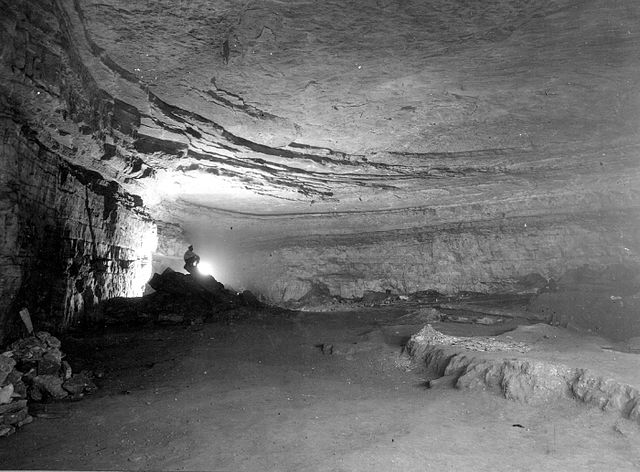Mammoth Cave National Park in Kentucky includes the most extensive cave system
known in the world. More than 367 miles of cave passageways have been mapped, and
there may be more miles still uncharted. The national park preserves this cave system along with Kentucky’s Green River Valley and the surrounding hills. Since becoming a national park in 1941, the area has also been designated a World Heritage Site and an international Biosphere Reserve.
Mammoth Cave started to develop 350 million years ago in a layer of limestone. Over 70 million years, water slowly dissolved the stone and left the extensive network of tunnels. Then a new layer of rock, sandstone, formed a stable roof for the tunnels. Different layers of tunnels were formed by the Ohio River during the Tertiary and Quaternary Periods. Most of the caves are now dry, but the lower level of tunnels continues to be carved by the Green River, which is 450 feet underground. It can be seen outside, where it emerges along the eastern border of the park. When the river floods, whirlpools swell back into the cave system; similar whirlpools formed the cave’s larger rooms millions of years ago.
Anthropologists believe that Native Americans first found the caves about four thousand years ago. Artifacts like torches, pottery, woven cloth and petroglyphsshow that people explored the cave network for two thousand years. They likely lived at the entrances and mined the tunnels for salt, gypsum, mirabilite and other minerals.
Why did the natives leave the area? Nobody knows for certain, but a gruesome 20th
century points clearly in one direction. In 1935, cave guides found the mummified
remains of a gypsum miner. He’d been crushed by a 5-ton boulder! Park officials named him “Lost John”. Several other ancient bodies were preserved in Mammoth Cave, and most seem to have buried there on purpose. One mummy was sold to P. T. Barnum. Lost John was displayed until the 1970s, when he was given a proper burial.
White settlers first arrived in the 18th century. Miners starting taking saltpeter (potassium or calcium nitrate crystals) in 1792; it was used to make gunpowder. The saltpeter demand dwindled after the War of 1812, but word of the unusually large cave system spread. Mammoth Cave quickly became a tourist attraction. By 1816, crowds of people in formal attire chiseled their names and the date into the cave walls. (Nowadays, people are encouraged to wear sneakers, and the practice of leaving messages is forbidden.)
Under the direction of a slave-owner and prospector named Franklin Gorin, a 17-year-old slave named Stephen Bishop began charting much of the network in 1830. Bishop was praised for his genius in many areas, and he excelled in geology. He explored the caves for many years and was the first to cross the now-famous Bottomless Pit. This opened the cave to further exploration. In 1839 he found two rivers and their odd eyeless inhabitants. In 1840 he discovered Mammoth Dome, a 192-foot tall structure draped in stalactites. Stephen’s discoveries continued until his death in 1857
Today the National Park Service makes many tours available. These range from the hour-long Mammoth Passage Tour, which is less than a mile long, to the 6-hour Wild Cave Tour that passes through five miles of the cave network. Some tours are pre-lit, but others require tourists to carry a paraffin lamp. Photography and videotaping are allowed. The cave is always chilly, so visitors are advised to bring a warm layer of clothing.
Explorers might spot some of 130 rare animal species. These include bats, beetles, fish, and the endangered Kentucky cave shrimp. It is blind and albino; there is little need for sight or pigment in the depths of a cave. At least eleven other Mammoth Cave species are eyeless and unpigmented.
After the darkness of spelunking, cave visitors might enjoy catching sunlight along
Mammoth Cave National Park’s 70 miles of trails. These are open to hikers, bikers, and horseback riders.
Discover more from LandmarkLocation.com
Subscribe to get the latest posts sent to your email.


